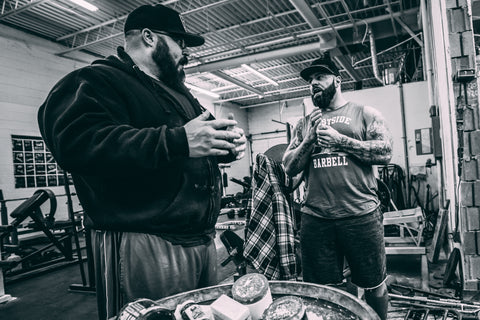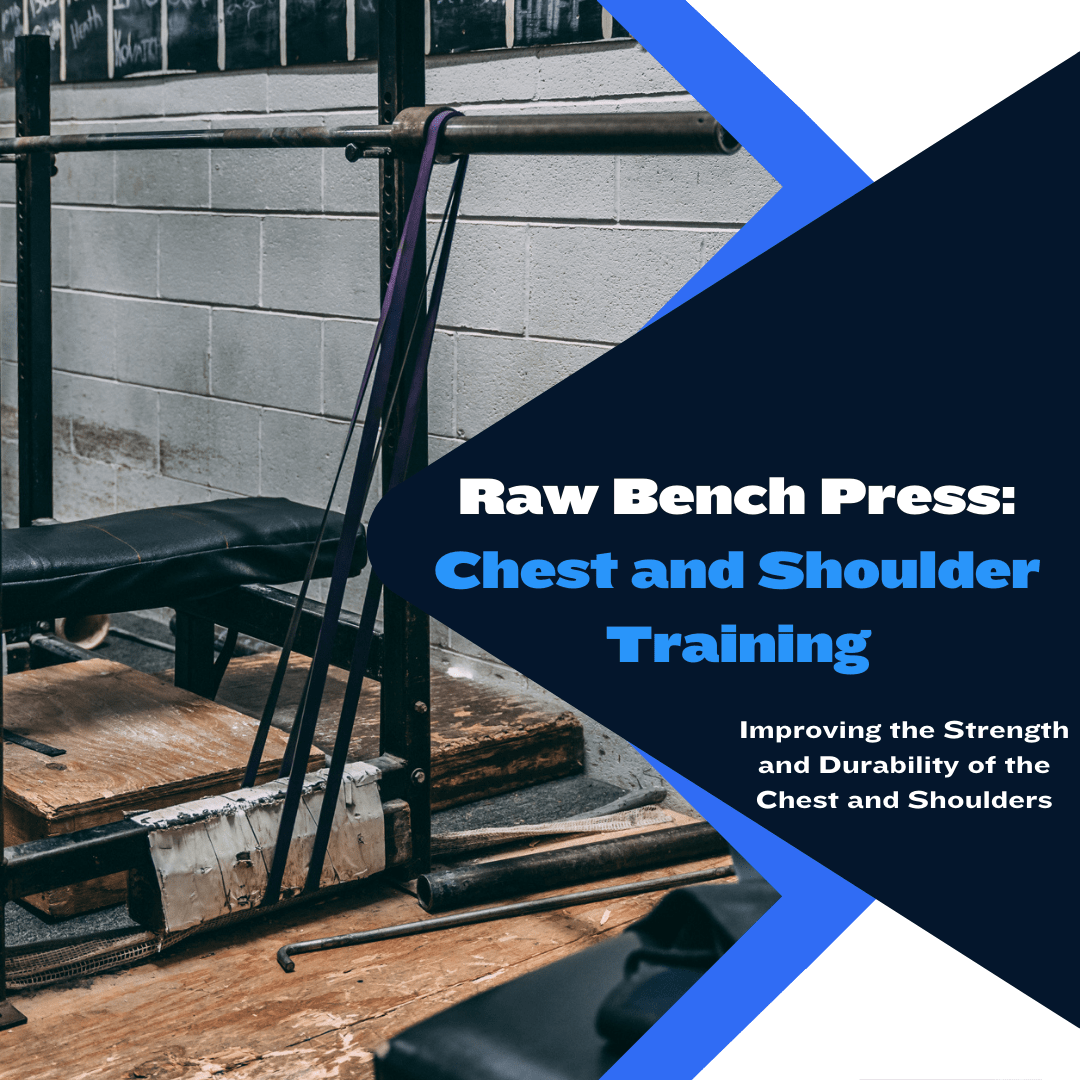Raw Bench Press Training: Chest and Shoulders

Westside Barbell has used the Conjugate Method for decades to build some of the strongest bench presses in powerlifting. Westside has produced numerous 800, 900, and 1000lb+ bench presses in gear, and the gym has also made multiple 500 and 600lb raw bench presses. Gear or raw, our methods, when employed correctly, can take your bench press to the next level.
One of the reasons our training methods are successful is the use of special and accessory exercises. Using these exercises, we can design optimized programming to attack identified weaknesses and quickly improve an athlete’s strength and skill.
Unlike linear-based periodization, the Conjugate Method allows manipulation of training on the fly to ensure an athlete’s training is as efficient and specific as possible based on current training feedback. This means we constantly evaluate the athlete, check for weaknesses, and adjust main and accessory exercise selections based on our findings.
This process ensures training always meets the athlete where they are currently at, not where a fixed program expected them to be.
When building the raw bench press, the chest and shoulders are two of the most essential muscle groups an athlete must build. Unlike the gear bench press, where much of the burden is placed on the athlete towards lockout, the raw bench press places a significant demand on the chest and shoulders of an athlete. It’s simple: if a muscle group or groups will be under stress, we must build them to be capable of regularly handling that stress.
Below, we will discuss ways to build and strengthen the chest and shoulder muscles to improve the raw bench press.
Main Exercises
One of the best ways to rapidly increase the strength of the chest and shoulder muscles is to select max-effort main exercises that place specific demands on these muscle groups. As mentioned above, we want to improve the strength and mass of the shoulders. Max effort training will allow for rapid improvements in absolute strength of the upper torso and will have significant carryover to the raw bench press.
When performing these exercises, we will work up to 1-3 reps to reach at least 90% training intensity. Remember, the demand these exercises will place on the chest and shoulders calls for the athlete to remain strict in their execution. Pec and shoulder injuries can quickly occur if an athlete makes the wrong call in weight or gets lazy with their execution.
Here are a few of our go-to chest and shoulder-focused main exercises we use at Westside Barbell to improve the raw bench press:
Chest-Focused
Bench Press (wide, close, or competition grip)
Incline Bench Press
Bench Press to 1 Board
Low Pin Press (pin set just above the chest)
Spoto Press
Incline Pin Press (pin set at chin level)
Shoulder-Focused
Push Press
Strict Press
Z Press
Standing Overhead Pin Press (pin set at chin level)
Seated Overhead Pin Press (pin set at chin level)
For powerlifters, we recommend sticking to the chest-focused main exercises more often and using accessory training to focus on shoulder strength development. However, out of four max effort upper training days per month, one exercise featuring a shoulder-focused exercise would be acceptable.
Powerlifters require specific bench press training considering the technical demand placed upon an athlete during the max effort bench press.
For athletes, an even mixture of chest and shoulder-focused exercises can be used regularly. Considering these athletes need to build diverse skill sets to meet the demands of their respective sports, it is important to avoid establishing a bias towards one style of pressing.

Accessory Exercises
While our main exercises allow us to train both the chest and shoulder muscles simultaneously, accessory exercises will enable us to focus on these muscles more specifically. Using multi and single-joint accessory exercises, we can train the chest and shoulders simultaneously and individually. Provided the proper set and rep scheme are applied, hypertrophy is easily achieved, improving muscle mass.
Strength and size are critical When building the chest and shoulders for the raw bench press. The level of absolute strength an athlete possesses is most important. However, as athletes develop the chest and shoulders, press range of motion is reduced, allowing for more advantageous joint angles to be achieved off the chest.
This means not only are you getting stronger, but the press is becoming more manageable due to a decreased range of motion.
Here are a few of our go-to chest and shoulder-focused accessory exercises we use at Westside Barbell, along with the recommended set and rep schemes for each exercise:
Chest-Focused
Dumbbell Bench Press - 4 x 8-10 or 10-12
Incline Dumbbell Bench Press - 4 x 8-10 or 10-12
Dumbbell Floor Press - 4 x 8-10 or 10-12
Standing Chest Press - 4 x 8-10, 10-12, or 12-15
Dumbbell Pec Fly - 3 x 10-12 or 12-15
Pec Deck - 3 x 10-12 or 12-15
Shoulder-Focused
Standing Dumbbell Overhead Press - 4 x 5-8, 8-10, or 10-12
JM Press - 4 x 5-8 or 8-10
Standing Dumbbell Strict Press - 4 x 5-8, 8-10, or 10-12
Dumbbell Lateral Raise - 3 x 10-12 or 12-15
Dumbbell Front Raise - 3 x 10-12 or 12-15
Rear Delt Fly - 3 x 10-12 or 12-15
Cable Face Pull - 3 x 12-15 or 15-20
Remember, not only can an athlete use the exercises mentioned above during accessory exercise training, but an athlete can also use the previously mentioned main exercises.
When using a main exercise as an accessory exercise, we must adjust the set and rep scheme accordingly. We recommend performing 3-5 sets of 5-8 or 8-10 reps when performing a main exercise as an accessory exercise. When organizing accessory exercises, we will perform multi-joint movements first, followed by single-joint movements.

Reduce Your Injury Risk
Whether you are a powerlifter or a conventional athlete, improving the strength and muscle mass of the chest and shoulders is essential to enhance sports performance and lower the risk of injury to the upper torso. We can never totally prevent an injury from occurring, but we can impact the durability and resilience an athlete displays when exposed to the risk of sports activities.
The exercises mentioned above offer many ways to improve the strength, durability, and size of two often weak points of the upper torso - the chest and shoulders. Too often, athletes are sidelined from training or sport due to pain or injury associated with both muscle groups. By training these muscle groups efficiently, we can improve sports performance and upper torso durability.
While strength and conditioning programming can be a complicated process, one rule always remains true: a bigger and stronger athlete is a more resilient athlete. Directly training weak points and improving the strength and durability of these muscle groups is critical to the success of all athletes.
The raw bench press can be a demanding exercise in both strength and technique. Having all associated muscle groups adequately trained ensures the athlete can complete the lift successfully and has the durability necessary to withstand the demands of both training and competition.
Sources:
Simmons, L. (2007). Westside Barbell Book of Methods. Westside Barbell.
Verkhoshansky, Y., & Siff, M. C. (2009). Supertraining. Verkhoshansky.
Zatsiorsky, V. M., & Kraemer, W. J. (2006). Science and Practice of Strength Training. Human Kinetics





